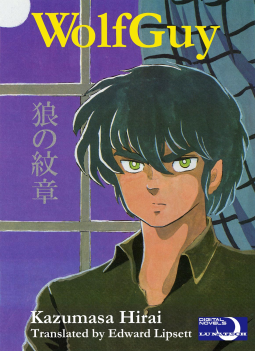
WolfGuy
Wolfcrest
by Kazumasa Hirai / Translated by Edward Lipsett
This title was previously available on NetGalley and is now archived.
Send NetGalley books directly to your Kindle or Kindle app
1
To read on a Kindle or Kindle app, please add kindle@netgalley.com as an approved email address to receive files in your Amazon account. Click here for step-by-step instructions.
2
Also find your Kindle email address within your Amazon account, and enter it here.
Pub Date Sep 01 2015 | Archive Date Feb 08 2017
Description
WolfGuy is significant milestone in the history of Japanese SF.
It’s created in 1971 by the Japanese SF author Kazumasa Hirai, who is famous for “8 Man”, and “Genma Wars –HARMAGEDON”, and upon its publication, it hit an extraordinary success and left the huge impact on Japanese entertainment fields, from novels, comics, animation, to video-games.
The cover illustration was done by Rumiko Takahashi, the author of “InuYasha” and“Urusei Yatsura”.
[story]
Akira Inugami is a transfer student who shows up at the troubled school ruled by a son of yakuza guy.
Despite the violence from gang boys, Akira Inugami doesn't resist at all. However, he comes to the school without any injury next day.
His physical idiosyncrasy comes from his secret identity. He is a wolfguy, who becomes immortal under the full moon.
While Akira never reacts with their provocation, gang boys try to attack his respected beautiful lady teacher.
With their filthy behavior, wolf's anger of Akira Inugami howls around!
A Note From the Publisher
From 1970 to 1971, Manga “WolfGuy” is published with its story by Kazumasa Hirai, and its illustration by Hisashi Sakaguchi.
In 1973, a movie “Ookami no Monsyou”(Toho Co.,Ltd.) is out, starred by Taro Shigaki, Yusaku Matsuda, and so on.
From 2007 to 2012, Remade edition Manga WolfGuy is out with its scenario by Yoshiaki Tabata, its illustration by Ayumi Izumitani, and its Illustration director by Yuki Yogo.
The manga title is published in many countries.
[About the Author]
Kazumasa Hirai(1938/5/13 - 2015/1/17)
He is Japanese famous SF novelist, and a creator of the manga “8 Man”(1963). He also wrote the scenario of the animation “8 Man”.
“8 Man” is Japanese earliest cyborg super hero.
The mind of a detective police murdered by criminals are transferred into cyborg body, and he solves several issues, using his supernatural power, such as high speed movement with the accelerating instrument. On the other hand, the anime and manga well illustrate the worry and concern of the hero who lost his live body, and made a smash hit. Animation of “8 Man” is also aired in U.S.
In 1967, he also wrote the scenario of “Genma Wars”, and its illustration was done by Shotaro Ishinomori, the author of “Kamen Rider” and “Cyborg 009”.
It's the Armageddon story in which espers get together from all over the world to fight against the invasion of the Genma, the evil axis of the universe.
From 1979 to 2008, he wrote novel series of “Genma Wars”, and in 1983, it's made into animation movie, “Genma Wars –Harmagedon”, with its characters designed by Katsuhiro Otomo, the famous creator of “AKIRA”.
In 1969, he starts “Wolf Guy” series, with the hero who becomes an immortal wolf guy under the full moon.
The title was strongly appreciated and supported by young generation, and made a huge impact on the Japanese SF, light novel, and Manga from then on.
Kazumasa Hirai is considered to be a legendary author who established a basis of Japanese SF entertainment development in novel and comic fields.
Available Editions
| EDITION | Ebook |
| ISBN | 9784903343518 |
| PRICE | $4.99 (USD) |
Links
Featured Reviews
 Donde acaba e, Book Trade Professional
Donde acaba e, Book Trade Professional
Amazing adaptation from manga to novel. I enjoyed this reading very much.
 Sharon T, Reviewer
Sharon T, Reviewer
Wolfguy is a novel by the late Kazumasa Hirai and translated to English by Edward Lipsett. Akira Inugami is a transfer student who shows up at the troubled school ruled by a son of mobster. Despite the violence from gang boys, Akira Inugami doesn't resist at all. Despite beatings he keeps returning to school unscathed. He is a wolfguy, a werewolf that heals quickly and is very hard to kill. When things escalate the gang attacks his the teacher that has shown him respect and care. Their filthy behavior fuels the wolf's anger.
Wolfguy is both more and less than I expected. The story is much more complex than a simple summary can express. the point of view varies between Akira, the teach in question, and occasionally other characters. It is easy to follow, but I expect readers that are not familiar with the culture and folklore of the region would have a little trouble getting into the story. I have spent a significant about of time watching television and reading literature from Japan, so I fell into the world fairly easily. The corruption and politics involved in schools- and the need to save face is important to the set up of how the school got to be in the state readers (and Akira) find it in. The story, and the environment are all well described and the action is very well told. However, while I could picture the action, environment, and characters it all felt a little flat. Part of this could have been the trouble of translating and that I thought this would be a graphic novel (only because of the cover, I admit I did not read much about the book before requesting it).
Wolfguy is a solid story with significant action and great ideas. I found the actual writing to fall a little flat, but the ideas and action it convoyed to be interesting. I think this is more because of my personal preferences and translation rather than a reflection on the original work. Readers with some knowledge of Japanese culture might enjoy it more than others.






